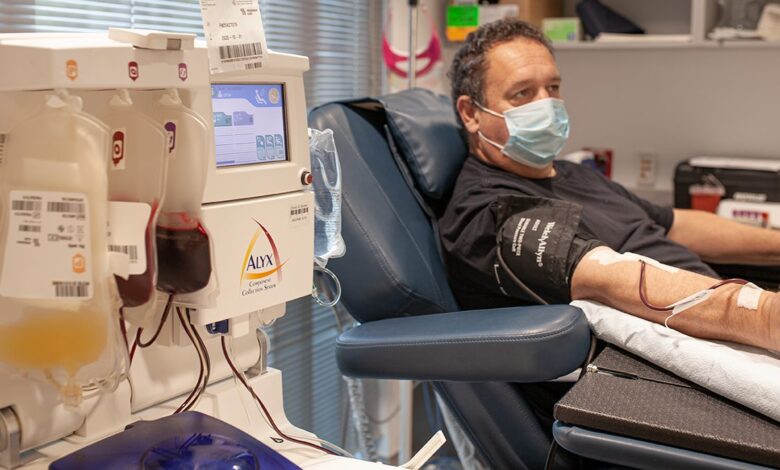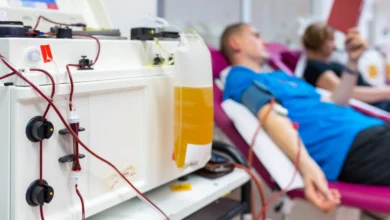Making a Difference: How to Donate Plasma in NJ

Donating plasma is a powerful means of assisting in the preservation of lives—and it can be simpler than one may assume. In New Jersey, occupants have various convenient choices to contribute to this vital cause. Whether you’re a novice donor or looking to provide frequently, comprehending the method, needs, and advantages can make your experience smooth and rewarding. In this article, we’ll lead you through how to donate plasma in NJ, where to go, and what to expect at each step of the way.
The empirical science behind plasma donation: Why it’s indispensable
Understanding plasma: The vital fluid of medical treatments
Plasma, the yellowish fluid component of blood, comprises about 55 percent of complete blood volume. It plays a pivotal role in supporting blood pressure and volume, transporting nutrients, hormones, and proteins to cells throughout the body. Furthermore, plasma is pivotal for protected function, containing antibodies and proteins that help the body fight diseases and infections. In a medical context, plasma is indispensable for various treatments, such as clotting factor deficiencies, liver disease, and serious burns. Plasma-derived therapies are advanced from the proteins discovered in blood plasma, and these therapies have been lifesavers for many patients with chronic conditions. Given the intricate role plasma plays in health and disease, comprehending its composition—chiefly comprised of water, electrolytes, enzymes, and proteins—is essential for grasping its impact in medical science.
The impact of plasma donation resonates profoundly, manifesting in diverse scenarios involving both acute and prolonged therapeutic needs. For instance, patients afflicted by hemophilia depend on frequent factor infusions extracted from donated plasma to circumvent hazardous bleeding that risks serious health complications. A particularly poignant case involves a mother recounting how her infant son’s survival hinged on immunoglobulin therapy, a treatment reliant on pooled human plasma. By relaying her experience, she not only underscores plasma donation’s significance but also the communal resolve required to ensure a steady supply of this life-preserving resource. Tales like these underscore how plasma donation translates into real interventions in people’s lives, transmuting potentially fatal circumstances into stories of hope and recovery.
Demystifying the Process: Insights Into Plasma’s Journey
What becomes of donated plasma is often mysterious to potential donors
Rigorously tested for pathogens, plasma must be safe for medical use. Tests scrutinize donations, looking for viruses or infections. What’s found? Nearly nothing, as donors are healthy individuals. Still, testing protects patients, ensuring plasma infusion or treatment involves no risk. Beyond extraction, the donation process focuses on preparation and storage. Plasma is separated from red cells and platelets through “plasmapheresis.” This sophisticated method maximizes plasma’s harvest while allowing multiple donations, since other components remain with the donor. Donated plasma may be frozen, preserving it for future needs. Comprehending plasma’s journey reinforces why we donate. Individual donations joined become a stockpile for urgent situations, and knowing this inspires the altruism at plasma donation’s core.
Where to Start: Identifying Donation Centers in Your Area
Evaluating Quality and Credibility at Top New Jersey Sites
In New Jersey, several accredited plasma donation centers certainly draw attention owing to their devotion to security, donor experience, and public engagement. Organizations like CSL Plasma and Grifols Biomat are paving the way with cutting-edge amenities and stringent protocols that ensure the welfare and protection of donors. These facilities not only meet federal standards but regularly exceed them through exhaustive coaching programs for team members, meticulously maintained gear, and adherence to the highest cleanliness benchmarks. Evaluating the reputation of plasma donation centers may involve examining reviews from past donors, inspecting their accreditations, and noting how they treat their volunteers. Quality plasma accumulation centers often interact with their communities by offering education and resources regarding the importance of plasma donation, cultivating an informed donor base while fostering a culture of giving.
Local Heroes: Highlighting Community-Powered Donation Initiatives
Public engagement is a pivotal aspect of plasma donation, leading to projects that go beyond the walls of donation centers. Local organizations or blood banks occasionally collaborate with schools, businesses, and community groups to host donation drives, making the process more accessible and raising awareness about the importance of plasma donation within the locality. For example, schools can create friendly competitions around plasma donation that engages students and educates them about health and altruism. Some centers organize themed donation events, tapping into local culture with food, art, and entertainment while increasing participation rates. These initiatives often generate a sense of belonging and collective responsibility, emphasizing that while each individual donation may seem small, when combined with others, it can lead to substantial contributions capable of saving lives.
Location plays an essential role in individuals’ willingness to donate plasma, as proximity to donation centers can significantly influence turnout. Those interested in giving should thoughtfully pick places convenient to reside or work, minimizing obstacles. Alternatively, mobile units visiting urban and rural areas address accessibility, reducing barriers for potential donors. Likewise, many centers’ flexible schedules accommodate diverse availability, aiding those unable to donate standard hours. As participation grows, strategic positioning becomes pivotal to sustain the supply relied on by recipients.
Expectations differ somewhat from initial assumptions. Required preliminaries help ensure smooth, fruitful visits. Commonly, health surveys probe medical histories and medications, permitting screening for eligibility. Identification validates identity while vital checks and iron levels indicate ability. Advance planning, like thorough hydration, eases the process. Moreover, a balanced pre-donation meal supports volume and nutrients, letting donors not just meet but optimize their experience.
Entering the donation center, both anticipation and nerves bubbled within. Upon arrival, donors would confirm their scheduled visits at reception, presenting identification for verification. A health screening then awaited, making sure all was well for contribution. Once given the all clear, the actual donation would unfold with comfort in recline. A needle found its home in a vein, and blood began drifting off into sterile collection. The plasmapheresis procedure efficiently sorted plasma from the remainder, returning the reds and plates to flow through the donor’s circuits once more. The full process could take anywhere from forty-five minutes to one hour’s time, after which attendees would be watched a short while for reaction monitoring. The involved methods were most regulated, ensuring safety and sterile operation while prioritizing the ease of givers.
Post-Donation Care: Tips for a Smooth Recuperation
The expedition does not conclude once the plasma contribution is finished. Post-donation maintenance is essential for ensuring a smooth recovery and can significantly impact the overall contribution experience. Donors are frequently counseled to relax for a concise period while enjoying refreshments offered by the center, which may include juices and snacks aimed toward replenishing vigor and blood sugar levels. Hydrating post-donation is just as crucial as pre-donation; drinking ample fluids aids the body restore its equilibrium. Recipients must also monitor their body’s response in the hours and days following the contribution, watching out for any signs of tiredness or discomfort. Participating in mild physical activity is generally encouraged, but strenuous workouts should be avoided for a day or two. This holistic approach to recovery underscores the importance that donation centers place on donor health, emphasizing that caring for oneself contributes to maintaining a cycle of giving.
The community bond of plasma donation
Joining the Movement: Constructing a Community of Contributors in NJ
The establishment of a societal norm promoting plasma donation necessitates more than solitary contributions. It requires nurturing a community embracing the imperative, where varied voices collectively champion the cause. In the Garden State, grassroots collectives and advocacy groups play a pivotal role rallying citizens to understand plasma donation’s life-saving importance. By crafting online and offline platforms for engagement—like social networking campaigns, educational workshops and neighborhood health expos—these organizations mobilize individuals to become repeat donors, applauding compassion while cultivating a feeling of unity. Countless residents contribute to the movement by candidly recounting their personal experiences or enthusiastically participating in planned community events, kindling interest in others. Collaborative efforts such as donor commemoration days or gestures of appreciation not only highlight the selfless act of regularly donating but the interpersonal bonds cultivated within locales dedicated to this cause. These local initiatives demonstrate that when inhabitants unite behind a common purpose, they can weave a resilient web of care and encouragement uplifting all involved.
Personal Stories: Meet Real Donors and Their Motivations
Personal motivations to donate plasma in NJ often vary greatly, from deeply emotional experiences to a simple desire to aid others in need. Hearing firsthand accounts from actual donors can encourage potential donors to ponder taking action themselves. Many share anecdotes about loved ones who have benefitted from plasma-derived therapies, serving as a profound reminder of the immediate impact their donations can have on real people. For instance, a retired nurse with decades of experience in healthcare may divulge how her career awakened her to the pressing requirement for plasma while a college sophomore explores how he opted to donate upon learning about the life-changing treatments made attainable thanks to the altruism of everyday citizens. Such stories make the process more human and offer insight into the diverse backgrounds of donors and what inspires them emotionally. It illustrates that contributing plasma is about more than just a physical gift; it’s about connecting lives—even indirectly—and feeling part of something more significant than oneself.
How Plasma Donations Impact Lives: An Insider Look at Recipients’ Journeys
Seeing firsthand the profound effects of plasma donation can be a moving experience, especially considering the paths of those who receive it. Many individuals recovering from grave sicknesses or undergoing operations rely on plasma transfusions to aid their recovery process. Relay the story of a patient requiring plasma-driven therapies and how area donations specifically influenced their journey from illness to health. For example, retell the tale of a cancer survivor whose life was spared through repeated plasma infusions during chemotherapy treatments. Their story underscores the transformative power of generosity from donors, highlighting the tangible outcomes of altruism. Such narratives celebrate not only successful recoveries but also serve as a summons to action, motivating others to donate plasma so that additional lives can experience similar transformations. By demonstrating the interconnectedness of donors and recipients, this segment crystallizes the worth of community involvement in plasma donation, fostering a sense of purpose and encouragement for all involved.



